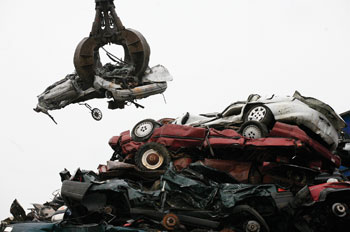
The “cash for clunkers” program is supposedly wildly successful. According to proponents, consumers are spending money once again on expensive, big-ticket items; gas-guzzlers are being removed from the road; and new-car sales are soaring, benefiting not just the automobile manufacturers, but the economy as a whole.
As just about everybody in America now knows, consumers can receive federal rebates of up to $4,500 by trading in their old, fuel-inefficient cars for new, more fuel-efficient ones. So many consumers jumped at the opportunity to take advantage of this government enticement that the $1 billion Congress initially authorized for the program was almost totally exhausted by the first week’s worth of rebates, causing politicians who equated “consumer participation” with “success” to scramble to provide another $2 billion for the program. That latest installment of funds should keep the program on the road through Labor Day, the Obama administration, a strong advocate of the program, says.
But is the extent of consumer participation and the money they spend the best way to measure the success of the “cash for clunkers” program? Consumers participate, of course, because they are able to get more money for their old cars than the old cars are worth — in many cases thousands of dollars more. So that means that the government enticements benefit the economy, right? Well, if that were the case, then why not sweeten the government-subsidized deals? Wouldn’t that benefit the economy even more?
Obviously, even more consumers would participate in the “cash for clunkers” program if the rebates were bigger, or if the definition of “clunkers” were extended to cover a larger number of used cars. Just think of how many more cars Detroit could produce and sell if the federal rebates were increased to (say) $10,000 and then applied to any deal where the difference in gas mileage between the sale of a “clunker” and the purchase of a new car were just one mile per gallon or more! Wouldn’t such a turbo-charged “cash for clunkers” program generate even more car sales than the current model?
And if a turbo-charged “cash for clunkers” program is not sufficient to jump-start the economy, then why not dispense with the “clunkers” part of the program altogether and simply give each consumer a big, fat voucher that can be redeemed when purchasing a new car (a very fuel-efficient new car, of course)? In fact, why not design the “cash for new cars” program so that the government will pay for the full amount of each new car purchase?
 Detroit would sell a lot more cars then. In fact, Detroit would not be able to keep up, no matter how hard it strived to ramp up production. But would the resulting surge in car sales to eager consumers willing to take possession of the government-paid cars at no cost to themselves really get the economy going again?
Detroit would sell a lot more cars then. In fact, Detroit would not be able to keep up, no matter how hard it strived to ramp up production. But would the resulting surge in car sales to eager consumers willing to take possession of the government-paid cars at no cost to themselves really get the economy going again?
Silly, isn’t it? Yet the only thing that makes the current “cash for clunkers” program less silly in terms of its supposed benefit to the economy is the fact that government is subsidizing only a part of the cost of the deals instead of the entire amount.
The government has no wealth of its own, and the money it spends to finance the “cash for clunkers” program must be siphoned out of the economy — the very economy that the program is supposed to help. If the money for the program is borrowed and created out of thin air through the Federal Reserve, then the newly created dollars interjected into the economy will erode the value of already existing dollars, causing prices to rise for goods and services, including cars.
In short, the program is a wealth-redistribution scheme benefiting the auto industry (albeit only as long as the program is kept alive by Washington) and some consumers at the expense of the economy as a whole. There is no overall economic gain.
Well, actually, it is even worse than that, since the government is having all of the “clunkers” it is paying for destroyed, which means that the cost to the government (and ultimately the American people) is not merely the benefit the consumer derives (the difference between the market value of the cars and the value of the rebates) but the entire cost of the rebates. Supposedly this destruction of many still-useful vehicles will help the economy since those vehicles get lower gas mileage than the government deems advisable.
This “logic” ignores the fact that destroying goods that still possess market value can only hurt the economy. (If the opposite were the case, then the government could also help the economy by buying and destroying older homes and factories and replacing them with new, more-efficient ones.) The “logic” also ignores the effect that the reduction in the number of used cars will have on the price of used cars (the price will go up). And it assumes that consumers do not factor in the price of gasoline when buying cars.
If this government program is a huge success, one would hate to contemplate what would constitute failure.
— Photo: AP Images


